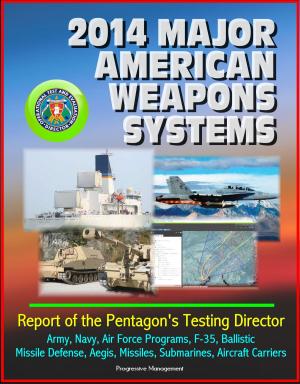National Industrial Security Program (NISP) Operating Manual - DoD 5220.22-M - Preventing Unauthorized Disclosure of Classified Information, Contractor Guidelines, Security and Secrecy Classifications
Nonfiction, Social & Cultural Studies, Political Science, Politics, Law Enforcement| Author: | Progressive Management | ISBN: | 9781476451640 |
| Publisher: | Progressive Management | Publication: | April 7, 2012 |
| Imprint: | Smashwords Edition | Language: | English |
| Author: | Progressive Management |
| ISBN: | 9781476451640 |
| Publisher: | Progressive Management |
| Publication: | April 7, 2012 |
| Imprint: | Smashwords Edition |
| Language: | English |
The National Industrial Security Program (NISP) Operating Manual provides baseline standards for the protection of classified information released or disclosed to industry in connection with classified contracts under the NISP, with contractor guidelines and security and secrecy classifications.
Contents: General Provisions and Requirements * Security Clearances * Security Training and Briefings * Classification and Marking * Safeguarding Classified Information * Visits and Meetings * Subcontracting * Information System Security * Special Requirements * International Security Requirements * Miscellaneous Information
This Manual is issued in accordance with the National Industrial Security Program (NISP). It prescribes the requirements, restrictions, and other safeguards to prevent unauthorized disclosure of classified information. The Manual controls the authorized disclosure of classified information released by U.S. Government Executive Branch Departments and Agencies to their contractors. It also prescribes the procedures, requirements, restrictions, and other safeguards to protect special classes of classified information, including Restricted Data (RD), Formerly Restricted Data (FRD), intelligence sources and methods information, Sensitive Compartmented Information (SCI), and Special Access Program (SAP) information. These procedures are applicable to licensees, grantees, and certificate holders to the extent legally and practically possible within the constraints of applicable law and the Code of Federal Regulations.
The NISP was established by Executive Order (E.O.) 12829 (reference (a)) for the protection of information classified under E.O. 12958 (reference (b)) as amended, or its successor or predecessor orders, and the Atomic Energy Act of 1954 (reference (c)), as amended. The National Security Council is responsible for providing overall policy direction for the NISP. The Secretary of Defense has been designated Executive Agent for the NISP by the President. The Director, Information Security Oversight Office (ISOO), is responsible for implementing and monitoring the NISP and for issuing implementing directives that shall be binding on agencies.
The Secretary of Defense, in consultation with all affected agencies and with the concurrence of the Secretary of Energy, the Chairman of the Nuclear Regulatory Commission (NRC) and the Director of the Central Intelligence Agency (CIA), is responsible for the issuance and maintenance of this Manual. The Secretary of Energy and the Chairman of the NRC are responsible for prescribing that portion of the Manual that pertains to information classified under reference (c), as amended. The Director of National Intelligence (DNI) is responsible for prescribing that portion of the Manual that pertains to intelligence sources and methods, including SCI. The DNI retains authority over access to intelligence sources and methods, including SCI. The Director of the CIA may inspect and monitor contractor, licensee, and grantee programs and facilities that involve access to such information. The Secretary of Energy and the Chairman of the NRC retain authority over access to information under their respective programs classified under reference (c) as amended. The Secretary or the Chairman may inspect and monitor contractor, licensee, grantee, and certificate holder programs and facilities that involve access to such information.
The National Industrial Security Program (NISP) Operating Manual provides baseline standards for the protection of classified information released or disclosed to industry in connection with classified contracts under the NISP, with contractor guidelines and security and secrecy classifications.
Contents: General Provisions and Requirements * Security Clearances * Security Training and Briefings * Classification and Marking * Safeguarding Classified Information * Visits and Meetings * Subcontracting * Information System Security * Special Requirements * International Security Requirements * Miscellaneous Information
This Manual is issued in accordance with the National Industrial Security Program (NISP). It prescribes the requirements, restrictions, and other safeguards to prevent unauthorized disclosure of classified information. The Manual controls the authorized disclosure of classified information released by U.S. Government Executive Branch Departments and Agencies to their contractors. It also prescribes the procedures, requirements, restrictions, and other safeguards to protect special classes of classified information, including Restricted Data (RD), Formerly Restricted Data (FRD), intelligence sources and methods information, Sensitive Compartmented Information (SCI), and Special Access Program (SAP) information. These procedures are applicable to licensees, grantees, and certificate holders to the extent legally and practically possible within the constraints of applicable law and the Code of Federal Regulations.
The NISP was established by Executive Order (E.O.) 12829 (reference (a)) for the protection of information classified under E.O. 12958 (reference (b)) as amended, or its successor or predecessor orders, and the Atomic Energy Act of 1954 (reference (c)), as amended. The National Security Council is responsible for providing overall policy direction for the NISP. The Secretary of Defense has been designated Executive Agent for the NISP by the President. The Director, Information Security Oversight Office (ISOO), is responsible for implementing and monitoring the NISP and for issuing implementing directives that shall be binding on agencies.
The Secretary of Defense, in consultation with all affected agencies and with the concurrence of the Secretary of Energy, the Chairman of the Nuclear Regulatory Commission (NRC) and the Director of the Central Intelligence Agency (CIA), is responsible for the issuance and maintenance of this Manual. The Secretary of Energy and the Chairman of the NRC are responsible for prescribing that portion of the Manual that pertains to information classified under reference (c), as amended. The Director of National Intelligence (DNI) is responsible for prescribing that portion of the Manual that pertains to intelligence sources and methods, including SCI. The DNI retains authority over access to intelligence sources and methods, including SCI. The Director of the CIA may inspect and monitor contractor, licensee, and grantee programs and facilities that involve access to such information. The Secretary of Energy and the Chairman of the NRC retain authority over access to information under their respective programs classified under reference (c) as amended. The Secretary or the Chairman may inspect and monitor contractor, licensee, grantee, and certificate holder programs and facilities that involve access to such information.















